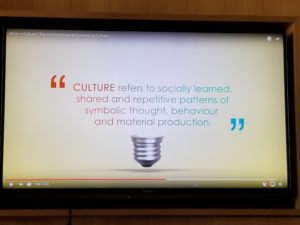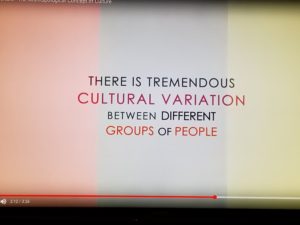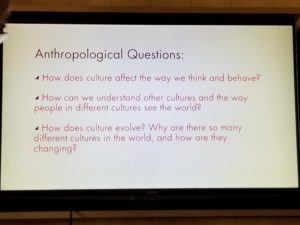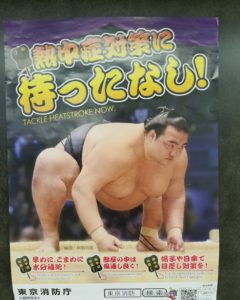
One of the coolest things we wanted to experience in Japan was the famous Sumo wrestling. Tickets were expensive and very hard to get yet my dad was determined to experience Sumo. We finally got tickets for Tuesday, September 19th. My dad wanted to see the ceremonies (we had no idea what those were either) which started at 14:20. Naturally, we arrived at 13:00, leaving us an hour and twenty minutes to check the place out until the ceremony started.
The first rule of Sumo, we can talk about Sumo.
When we walked into the stadium, we faced a huge room with a wall of people on the other side. We showed our tickets to the lady working at the stadium and asked her if she could tell us where our seats were located. In Japan, most people don’t speak English, but we were in luck. We were on the second floor, row 6, seats 3-8. I didn’t realize at first that there were only two floors. In comparison to a soccer or football stadium, this was tiny, holding a little over 10,000 people. The bottom floor had rows and rows of pillows that people would sit on to watch the matches. Hours seated in the small folded position with legs crossed! The second floor had fixed velvet chairs in which we sat, and all of the restaurants were on that level. Only people seated in these sections with chairs could watch and eat. Strangely, the chairs had beer bottle openers attached with string to each little table. We remarked that in America, those would be gone in minutes. No one steals anything in Japan.
 Next, we went looking for was food. In Sumo, chicken is a symbol of good luck because chickens stand on two legs and wrestlers need to stay on their feet to win. There were bento boxes, chicken skewers, and a sit-down restaurant. I love chicken, so I got the chicken skewers with fries. It tasted way better than I expected. We were allowed to take our food to our chair seats, so we could eat while Sumo matches took place.
Next, we went looking for was food. In Sumo, chicken is a symbol of good luck because chickens stand on two legs and wrestlers need to stay on their feet to win. There were bento boxes, chicken skewers, and a sit-down restaurant. I love chicken, so I got the chicken skewers with fries. It tasted way better than I expected. We were allowed to take our food to our chair seats, so we could eat while Sumo matches took place.
In the Japanese sport of Sumo Wrestling, over 600 fighters called Rikishi strive to become the Yokozuna. The Yokozuna is the highest and most prestigious rank for Rikishi. In order to achieve this goal, the Rikishi must win many battles called bouts. In order to be eligible to become a Rikishi, you must weigh a minimum of 100kg and endure rigorous training. Bouts are held in a Sumo stadium. In the center of the stadium, there is a 4.55m wide circle made out of rice and straw. The floor is clay with two white lines in the middle indicating where the Rikishi begin the match. Around the circle is a square made of the same materials.
While the bouts usually last no more than 10 seconds, the preliminary rituals are quite intricate. First, the Rikishi step into the fight circle, then walk to one of the corners of the square. In the corner, there is a box containing a lot of salt. The Rikishi scoop up the salt with their hands and throw it into the circle. This is to rid them of bad spirits. They then return to the circle. They stand approximately 2 feet away from their white line. They lift their legs and slap their thighs then return to their regular position. They then bend down and rest their fists on the floor. Once both Rikishi has their fists on the floor the bout begins.
https://www.instagram.com/p/BZOU5-SB8ox/
During a bout, 2 Rikishi fight to either knock their opponent out of the circle or cause any part of their body to touch the floor, other than the soles of their feet. The typical duration of a match is only 5-10 seconds, whereas the rituals leading up might be 3 to 4 minutes. Sumo wrestlers propel themselves forward towards their enemy and collide with 4,000 pounds of force. They fight using their own distinct moves until there is one victor. When a Rikishi has won, the referee designates the winner by pointing his war flag to the side from where the winner began. Once the match is over, Rikishi bow to each other and leave the arena. Interestingly, the referee also wears knives on his waist. Those knives are now symbolic, but long ago were used by the referee to commit suicide in the ring if he made a bad call or decision in the match, apparently out of shame!
Most of the time the Japanese people watching were quiet except for the occasional “ooh” or “ah.” When the matches become very close the crowd could become quite boisterous, a huge contrast to the Japanese people’s typical calm demeanor. During the crescendo of the final matches, the crowd was yelling and shouting. When the last match ended, the people sitting on pillows nearest the ring began to throw them into the ring in disgust. We learned the crowd did this because the underdog had defeated the favorite.
https://www.instagram.com/p/BZOVLlzBKRK/
Since we really knew nothing about it, Annika, Ali and I voted before each match as to who would win, as a way to keep us interested. Over 4 hours, there are a LOT of bouts. (The day actually begins at 8:00 am and ends at 18:00 pm) At first, I was more interested in the preparatory rituals, than the actual matches. There was always a quick winner and the matches rarely went on for more than 5 seconds. Then we got to the big ceremony, when all the senior level Rikishi walking out, forming a circle, and then the circle of Rikishi then walking off. This was interesting to see. But what really became interesting were the bouts that followed. These were much more exciting as they were using tricks during the rituals to psyche out their opponent. The matches were also much closer, and sometimes even took more than 30 seconds. There were about ten matches until another ritual ceremony. After this second ceremony, we got into big dude territory. You could almost feel the collision from hundreds of feet away. The crowd also got much more involved. These matches were really fun and exciting, making the whole day worth it!

All in all, we really enjoyed watching 300 to 600-pound people slam into each other. Next time, I would go later in the day and only watch the last 30 matches. While the ceremonies are interesting and eating the famous chicken skewers while watching sumo is amazing, I think arriving later and having the big matches be the primary focus might make the experience more enjoyable. I think that my overall sumo experience was quite enjoyable, and I would likely go again.
more links:
http://web-japan.org/kidsweb/virtual/sumo/sumo03.html
https://listverse.com/2014/12/18/10-fascinating-facts-about-sumo-wrestling/https://www.insidejapantours.com/blog/2014/09/16/11-amazing-things-you-probably-never-knew-about-sumo-wrestling/
11 amazing things you probably never knew about sumo wrestling
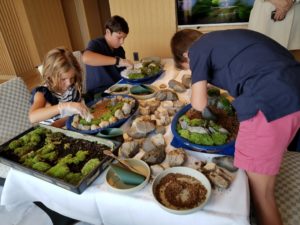
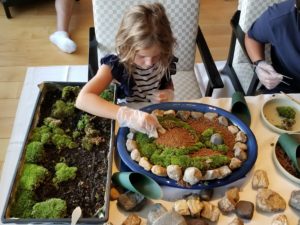


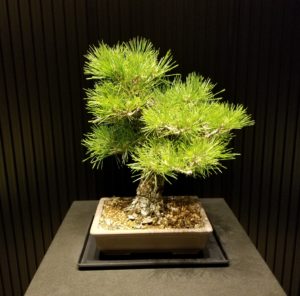



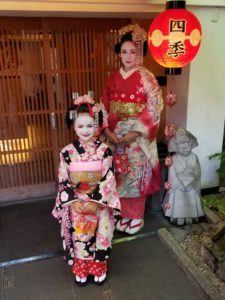 Growing up with only brothers, I’m not quite sure what exactly is the definition of “a little girls best day ever”, but I suspect heading out in Kyoto with Maman to get kitted up in full makeup as Geisha is pretty darn close.
Growing up with only brothers, I’m not quite sure what exactly is the definition of “a little girls best day ever”, but I suspect heading out in Kyoto with Maman to get kitted up in full makeup as Geisha is pretty darn close.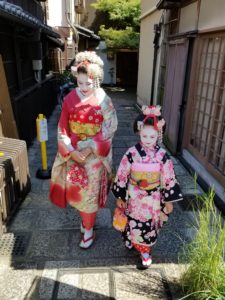

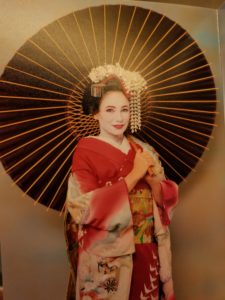
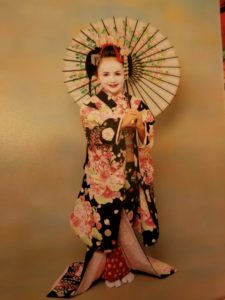



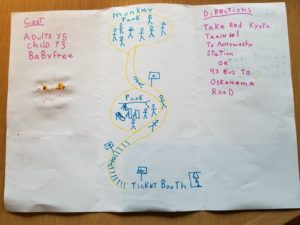

 Next, we went looking for was food. In Sumo, chicken is a symbol of good luck because chickens stand on two legs and wrestlers need to stay on their feet to win. There were bento boxes, chicken skewers, and a sit-down restaurant. I love chicken, so I got the chicken skewers with fries. It tasted way better than I expected. We were allowed to take our food to our chair seats, so we could eat while Sumo matches took place.
Next, we went looking for was food. In Sumo, chicken is a symbol of good luck because chickens stand on two legs and wrestlers need to stay on their feet to win. There were bento boxes, chicken skewers, and a sit-down restaurant. I love chicken, so I got the chicken skewers with fries. It tasted way better than I expected. We were allowed to take our food to our chair seats, so we could eat while Sumo matches took place.
